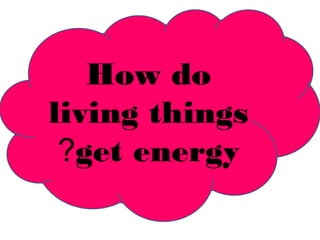
Living things get energy
- 1. How do living things ?get energy
- 2. Energy roles in ecosystems Every living thing need energy to stay alive and grow. Green plants use sunlight along with air and water to make sugar. Sugar gives plants the energy they need. Producer is the living thing that makes , .or produces, its own food
- 3. Many living things cannot make food. They get energy from food that they eat, or consume. Consumer: a living thing that .eats other organisms
- 4. When plants or animals die, their stored-up energy is unused. Decomposers use this energy. Decomposer : living thing that breaks down waste and dead .plant and animal matter
- 5. Puffins eat fish ( to get energy.(consumer
- 6. A fern plant takes in sunlight to (make food. (producer
- 7. Mushrooms break down a dead (tree for energy.(decomposer
- 8. Food chains
- 9. Most ecosystems get energy from - sunlight. - Plants and other producers transform the sun`s energy into food energy. Food chain is the transfer of energy from one living thing to .another
- 11. A food chain begins with energy from the sun Grasses use air, water, and energy from the Sun To make food Golden eagles eat prairie dogs. Energy passes from the prairie dog to the eagle Prairie dogs eat grass. Energy passes from the grass To the prairie dog
- 12. Food webs
- 13. Ecosystems have many food chains. - -Food chains combine to form a food web. Food web: is a system of overlapping food chains in an .ecosystem
- 14. Food webs show that energy flows in many different ways in an ecosystem. Energy can flow from one producer to many consumers. One consumer can be eaten by .many other consumers
- 16. Changes in food webs All the living things in a food web are connected. If one part of a food web is removed or changed, other parts change. -Prairie dogs build colonies on the grassy plains. -People also settle on these plains. -This reduces the habitat for prairie dogs. Their . numbers may decrease
- 17. Prairie dogs build . colonies on the grassy plains
- 18. People . also settle on these plains
- 19. With fewer prairie dogs to eat, black-footed ferrets may not have the food they need. The .ferrets may die out
- 21. This change can affect the badgers who eat ferrets. Badgers may have to look for .other food
- 23. Explain the changes in this food webs people badgers Black-footed ferrets Prairie dogs Grassy plains
